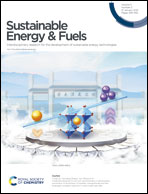Morphologically controlled rapid fabrication of rhodium sulfide (Rh2S3) thin films for superior and robust hydrogen evolution reaction†
Abstract
Aiming for the rapid fabrication of robust catalytic materials, we herein present rhodium sulfide (Rh2S3) thin films with high activity for the hydrogen evolution reaction (HER) in water splitting. A single-step aerosol-assisted deposition using a rhodium diethyldithiocarbamate precursor was employed for this purpose at an operating temperature of 500 °C. Manipulating only the deposition time yielded crystalline and phase-pure Rh2S3 films with self-organized and controllable nanostructured morphologies. The HER performance of the resulting films in acidic electrolyte was found to be largely influenced by these morphologies in addition to the metallic substrates (i.e., Ni foam (NF) and Ti foil (Ti)) used to form the working electrodes in an electrolytic cell. A blooming flower-like structure obtained in 80 min of deposition on a NF substrate (Rh2S3/NF-80) exhibited the highest catalytic activity. A detailed characterization indicated that the highly exposed surface characters and pronounced number of active sites were responsible for such an extraordinary performance. To produce current densities of 10 and 100 mA cm−2, the Rh2S3/NF-80 needed overpotentials (η) of 67 and 132 mV, the lowest reported for any rhodium sulfide material, while being comparable to the Pt benchmark catalyst. The Tafel slope for Rh2S3/NF-80 electrode was estimated to be 36 mV dec−1, suggesting that the HER followed the Volmer–Heyrovsky kinetic model. Furthermore, the current density outstretched to 350 mA cm−2 at an overpotential of just above 300 mV, thereby meeting the standards for large-scale application. With all these unprecedented structural and performance attributes, it is envisaged that the as-prepared Rh2S3 catalytic films would perform equivalently in many other catalytic operations.



 Please wait while we load your content...
Please wait while we load your content...